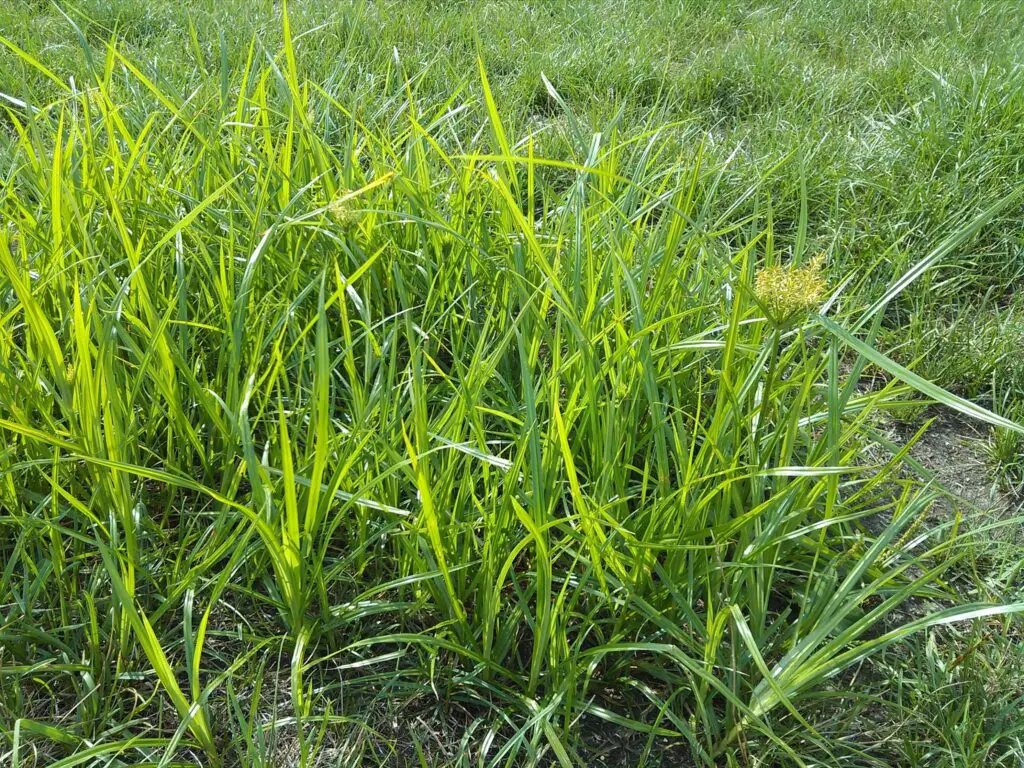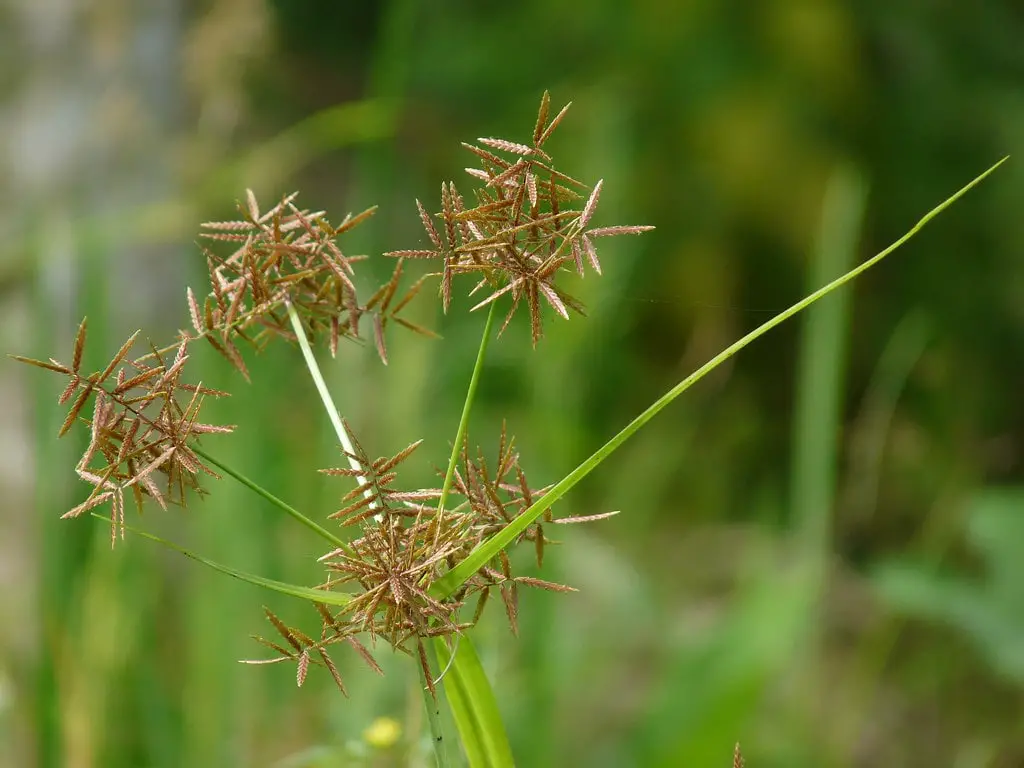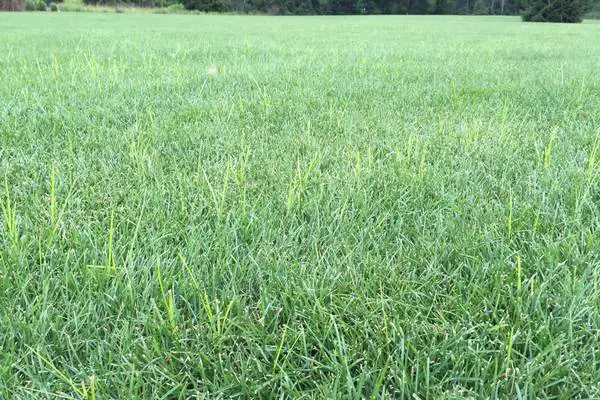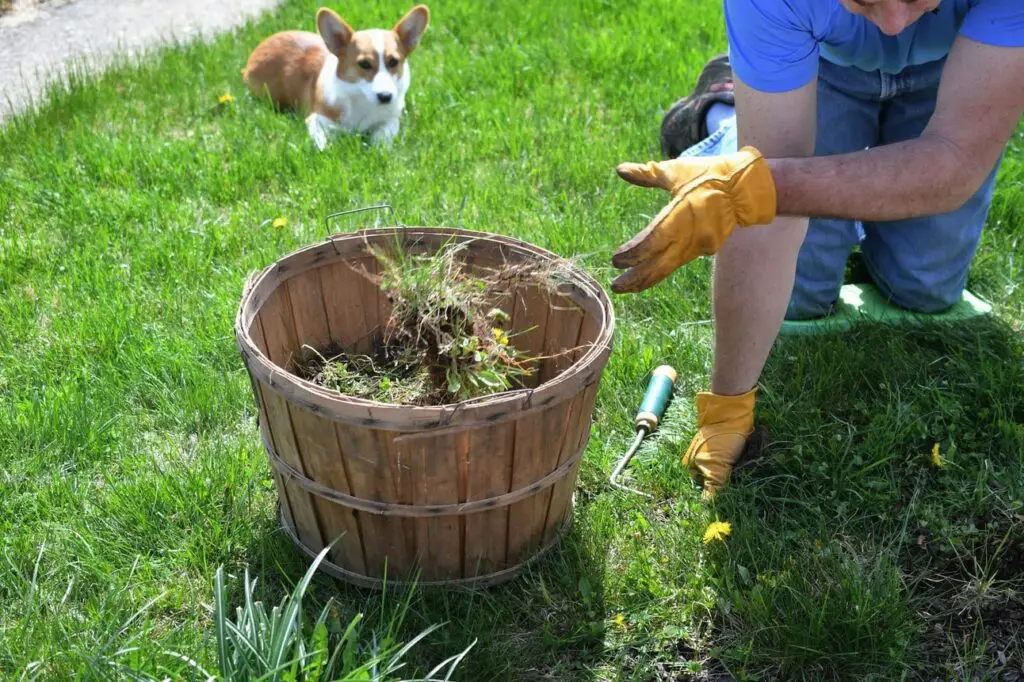You were looking at the grass in your lawn and noticed something.
If you have unsightly yellow nutsedge in your yard, you’re not alone.
This fast-growing, grassy type invasive weed is a common problem in lawns and can be challenging to get rid of.
It’s a common nuisance lawn plant that proliferates and spreads quickly.
Resistance to most over the counter herbicides, make it difficult to eliminate.
Fortunately, there are some proven ways to get sedges under control.
What is Nutsedge Weed?
Nutsedge is a perennial weed similar to grass, with a nut-like seed at the base of each stem.
It is characterized by its long, slender light to medium green leaves and nut tubers.
Nutsedge typically grows in areas that stay moist, wet, or have poor drainage.
It also likes full sun and thrives during the summer months.

Nutsedge Weed Identification
How to Identify Nutsedge in Your Lawn
It is essential to properly identify nutsedge so that you can take the necessary steps to remove it from your lawn.
Nutsedge (cyperus rotundus) is a perennial sedge that commonly invades lawns across the country.
It is a yellowish-green plant with triangular stem and leaves that closely resembles turfgrasses.
The leaves grow in pairs, and the edges of the leaves are serrated..
The stems can be flat, round, or triangular.
Plants grow from a single main stem and produce rhizomes (horizontal underground stems that grow just below the surface of the soil).
Correct nutsedge identification can be done by looking for the seedheads or the tubers to help determine the type you have.
The seed heads are dark brown and clustered at the top of the plant.
If you suspect you have nutsedge plants in your lawn but are unsure, you can take a sample of the weed to your local cooperative extension office for identification.
Once you confirm, you can take steps to remove it from your lawn.

What Does Nutsedge Look Like?
How Do I Know If I Have Nutsedge?
Warm-season turf grasses are a prime hiding place for sedges.
Nutgrass can easily blend in with grasses like centipede when the lawn is cut short.
However, when the grass is growing tall and un-cut for a week or two, you can easily spot nutsedge.
It is almost always much taller than the lawn grasses and lighter in color.
In darker grasses and thin bladed grasses like bermuda and zoysia, nutsedge is easily identified by its bright yellow flowers and triangular-shaped leaves.
It grows much faster than other grasses, so it quickly crowds out other plants in the lawn.

What’s the Difference Between Purple Nutsedge and Yellow Nutsedge?
If you’re trying to get rid of nutgrass in your lawn, you must identify the type of nutsedge you’re dealing with to treat it properly.
There are two main varieties of nutsedge: purple nutsedge and yellow nutsedge.

Both types of nutsedges are invasive weeds that can be difficult to control.
The visual difference between yellow and purple nutsedges is the purple variety has a reddish-purple color, while yellow nutsedge is yellowish-green in color.
Purple Nutsedge
Purple nutsedge is a perennial plant that has a grass-like appearance.
It grows between 6 and 15 inches tall, depending on the variety of nutsedge.
The leaves are dark green and long, with flat blades with parallel veins.
It is often darker than the turf grass next to it.
The stem has a noticeable reddish purple color to it.
Purple nutgrass is not very winter hardy and will die back during cold winters.
It dies in winter, but new growth comes up in spring.
Yellow Nutsedge
Yellow nutgrass is light green and appears yellow next to certain turfgrasses.
It is usually the variety most often spoken of and is a little more commonly found in these regions.

Where Does Nutsedge Grow?
Nutsedge looks similar to grass, but it is usually lighter in color, grows taller, and has a triangular-shaped stem.
It grows best in warm, moist conditions; and is often found in poorly drained lawn or garden areas.
Along with these areas, NG can also be found in cracks in sidewalks and driveways..
How Does Nutsedge Spread?
Nutgrass has the ability to proliferate rapidly in lawns and gardens, while crowding out desirable plants.
Nutsedge uses multiple means of reproduction; and spread by seeds, rhizomes, and nutlets, which is a form of tuber.
These primary propagation comes through its tubers, which are small, dark brown or black balls that form at the end of the plant’s rhizomes.
If allowed to grow to seed, the plant spreads by seed and tubers.
The tubers can detach from the plant and be transported by water, animals, or people to other areas where they will germinate and grow new plants.
Horizontal underground stems then send up new shoots and roots at intervals along their length.

How To Get Rid of Nutsedge
You can get lawn weeds out of your yard when you follow basic care instructions.
When you find these in your yard, these tips can help you figure out how to get rid of nutsedge in your lawn.

Herbicides: There are several herbicides that will kill nutsedge.
The most effective often contain herbicides like glyphosate or imazapyr.
However, glyphosate can damage other plants nearby.
SedgeHammer Turf Herbicide
Tenacity
Solarization: This method involves covering the infested area with clear plastic for several weeks during the summer, raising the soil temperature and killing the weeds.
Hand-pulling: This is the most effective method for small infestations.
Hand-pulling is often the best method for small infestations. However, they can quickly regrow from even a small piece of rhizome left in the ground.
Carefully dig up the plant, making sure to get all the roots.
Mulching: Mulching your lawn with a thick layer of organic material or tarp can kill weeds and grass and help discourage weeds from growing.

Nutsedge Identification and Treatment : Get Rid Of Nutsedge In Your Lawn
How To Kill Nutsedge
Nutsedge Chemical Control: With Herbicides
Nutgrass can be difficult to control using chemicals since it’s resistant to many popular herbicides.
There are a few herbicides that are effective at controlling nutsedge.
When should I spray for nutsedge for weed control?

Top Nutsedge Herbicides: Best Herbicides For Nutsedge
What kills nutsedge not grass?
IMAGE Kills Nutsedge Concentrate gives your lawn the look it deserves without the weeds. This is a selective, post-emergent weed killer used on southern turf grass and certain ornamentals. IMAGE herbicide targets some of the most difficult southern weeds, such as yellow and purple nutsedges, dollar weed, wild onions, and annual bluegrass. It contains a proprietary ingredient that kills weeds.
Useful for killing weeds in warm-season grasses. It kills nutsedge, dollarweed, and wild onion.
Sledgehammer.
Sledgehammer is an imazaquin herbicide that works by killing the roots of the nutsedge plant . This systemic herbicide will kill all of the plants and any other plants in the vicinity. This herbicide is safe for use around humans and animals. However, it should not be used if there are nearby water sources or if you have fish ponds.
Fusilade II.
Fusilade II is a fluazifop-p-butyl herbicide that works by preventing nutsedge from growing. Applying this product before the nutsedge emerges from the ground is essential. This product is only available to purchase from a professional.
Tenacity
Distinct.
Distinct is an acifluorfen herbicide that works by preventing the nutsedge from growing.
Tordon 22K and Tordon 4E.
Dual Magnum. Dual Magnum is a dimethenamid herbicide that works by killing the nutsedge plant.
Caparol.
Caparol works by causing Nutgrass to produce ethylene gas, which eventually causes the plant to die. While Caparol effectively kills Nutgrass, it can also damage other plants if they come into contact with the herbicide.
Apply Caparol to your lawn only when there is no wind, and be sure to wear gloves and long sleeves to avoid contact with the skin. .
Roundup. Roundup is a glyphosate herbicide that is effective at killing weeds and grass. Roundup for lawns kills many of the common weeds found in turf grass.
It is essential to follow the directions on the label when using this product since it can kill nearby grass and plants.
halosulfuron chlorsulfon
Most lawn herbicides can kill most of the broadleaf weeds in your yard.
But managing nutsedge infestation requires an effective treatment.
It’s best to spray them as soon as they sprout with a good post-emergent weed killer, and continue with good pre-emergents.
Nutsedge Cultural Control
Although nutsedge can be controlled with herbicides, cultural practices are the key to preventing its establishment and spread.
Mowing: Nutsedge thrives in mowed turf, so keeping your lawn mowed at the proper height is important.
Mowing too low will encourage nutsedge growth, while cutting too high will allow the weed to go to seed.
The best mowing height for most turfgrasses is 2-3 inches.

Watering:
Proper watering is essential for a healthy lawn that can compete with weeds.
Water early in the day so that the grass has time to dry out before nightfall.
Scheduling watering will help prevent fungal diseases that can weaken the turf and make it more susceptible to weeds.
Fertilizing:
A well-fertilized lawn is also more resistant to weeds.
Apply fertilizer at the recommended rate for your turfgrass species.
Be sure to follow all label directions carefully.
Using some or all of these cultural practices will help improve the health of your yard.
Does vinegar kill nutsedge?
Vinegar can be used to effectively control nutsedge in some cases.
That’s because vinegar contains acetic acid, which is found to be effective at killing or damaging plant tissue when applied at high concentrations.
Using vinegar as a foliar herbicide spray will often kill the leaves of the intended plant.
However, nutgrass is often difficult to control due to its deep root system; and ability to regenerate from small pieces of root sysstem.
Can I Pull Up Nutgrass?
Yes, you can definitely pull up nutgrass.
It is an easy procedure but requires a little time and effort.
How To Dig Up NutSedge
To dig or pull up this weed, take a shovel or digging tool; and
Identify the nutgrass plants
Water the area to soften the soil, which will make the root system easier to dig.
Use a shovel or garden fork to insert below the tubers and roots. Pry them loose and remove with the tool.
Once you have them out of the ground, dispose of the plants to prevent reinfestations.

How To Prevent Nutsedge From Coming Back
The best way to prevent it from growing is to keep the area around your home free of standing water.
You can prevent weed invasions by practicing good lawn care and giving your grass an edge over these weed pests. A healthy, vigorous lawn is an excellent defense against yellow and purple nutsedges.
Avoid overwatering and correct low-lying areas that are poorly drained. Instead of using shallow irrigation, water deeply but infrequently. This promotes deep roots and resilience.
If your soil is compacted, nutsedges thrive so you should aerate your lawn when necessary. Cut your grass at the recommended height for your type of grass. Too short mowing can cause turf grasses to become stressed and promote sedge growth.
How To Get Rid of Nutsedge
In conclusion, getting rid of nutsedge is not an easy task. However, it is possible to achieve success with the proper knowledge and tools. The most important thing is to be patient and consistent with your efforts. With time and perseverance, you can create a nut-free zone in your yard or garden..
turfgrass lawn care





